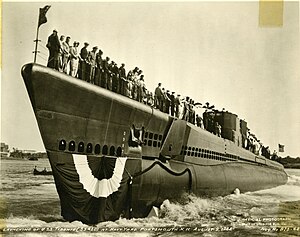USS Tirante (SS-420)
|
Tirante (SS-420) at her launch from Portsmouth Naval Shipyard.
|
|
| History | |
|---|---|
|
|
|
| Name: | USS Tirante |
| Builder: | Portsmouth Naval Shipyard, Kittery, Maine |
| Laid down: | 28 April 1944 |
| Launched: | 9 August 1944 |
| Commissioned: | 6 November 1944 |
| Decommissioned: | 20 July 1946 |
| Recommissioned: | 26 November 1952 |
| Decommissioned: | 1 October 1973 |
| Struck: | 1 October 1973 |
| Fate: | Sold for scrap, 21 March 1974 |
| General characteristics As completed | |
| Class and type: | Tench-class diesel-electric submarine |
| Displacement: | |
| Length: | 311 ft 8 in (95.00 m) |
| Beam: | 27 ft 4 in (8.33 m) |
| Draft: | 17 ft 0 in (5.18 m) maximum |
| Propulsion: |
|
| Speed: |
|
| Range: | 11,000 nautical miles (20,000 km) surfaced at 10 knots (19 km/h) |
| Endurance: |
|
| Test depth: | 400 ft (120 m) |
| Complement: | 10 officers, 71 enlisted |
| Armament: |
|
| General characteristics (Guppy IIA) | |
| Displacement: |
|
| Length: | 307 ft (94 m) |
| Beam: | 27 ft 4 in (8.33 m) |
| Draft: | 17 ft (5.2 m) |
| Propulsion: |
|
| Speed: |
|
| Armament: |
|
USS Tirante (SS-420), a Tench-class submarine, was the second ship of the United States Navy to be named for the tirante, a silvery, elongated "cutlass fish" found in waters off Cuba. Her keel was laid down on 28 April 1944 by the Portsmouth Navy Yard of Kittery, Maine. She was launched on 9 August 1944 sponsored by Mrs. William B. Sieglaff, wife of Commander Sieglaff, and commissioned on 6 November 1944 with Lieutenant Commander George L. Street III in command.
Following shakedown training in Long Island Sound, and the waters off Panama and Oahu, Tirante departed Pearl Harbor for Japan on 3 March 1945. The submarine patrolled the approaches to Nagasaki. There she sank the 703-ton tanker Fuji Maru on 25 March and followed with the sinking of the 1218-ton freighter Nase Maru three days later. After the latter attack, Japanese escorts kept Tirante down for seven hours, before she slipped away unscathed.
On 31 March, Tirante shelled and sank a 70-ton lugger with five-inch (127 mm)and 40-millimeter gunfire and,on 1 April,missed an LST-type vessel with a spread of three torpedoes. The submarine soon shifted to waters off the south coast of Korea, near the Strait of Tsushima. At twilight on 6 April, she battle-surfaced and captured a small Japanese fishing vessel and took its three crewmen prisoner before sinking it.
The following day, Tirante torpedoed a 2800-ton cargo freighter loaded with a deck cargo of oil drums. The submarine surfaced and directed a nearby Korean fishing craft to pick up two survivors. Although observers on the submarine reported witnessing the Maru's sinking, post-war examination of Japanese records failed to confirm it.
...
Wikipedia

